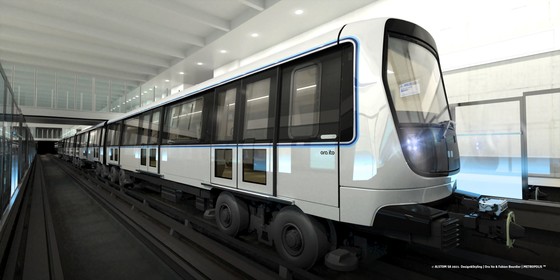
Métropole Aix-Marseille-Provence and Alstom unveil the design of the future metros for Marseille
Métropole Aix-Marseille-Provence and Alstom unveil the design of the future metros for Marseille
25 January 2021 – The teams of Alstom, of Métropole Aix-Marseille-Provence and Marseille designer Ora Ïto have finalised the exterior design and interior layout of the new trains for the Marseille metro, which should be on the rails by 2023.
Métropole Aix-Marseille-Provence, which wanted to involve all of the city's inhabitants in the choice of design for the state-of-the-art metros, launched a public consultation at the end of 2019 on the website www.marseillechange.fr. More than 17,000 people were thus given the opportunity to say what they thought. Out of three proposals devised by the Alstom group, the one nicknamed "Listen to the City" was selected by the inhabitants of Marseille with a majority of 44% of the votes.
This is the basis on which Alstom's teams, the designers Ora Ïto and Fabien Bourdier and the services of the Métropole started working in collaboration to apply the design concepts to all the elements of the metro. The design is centred on the light of Marseille, a welcoming city bathed in sunshine and the Mediterranean. The future metros will be lined with a play of blue trim on the outside and radiant interior harmony in warm, natural tones, colouring the muted spaces with a convivial touch. The passenger experience will be enhanced by a sound design inspired by the city's various emblematic landscapes. Vast reception areas will offer accessibility to all passengers, including people with reduced mobility with dedicated areas, improving the fluidity and capacity of the trains. With large bay windows, a sophisticated air-conditioning system and a modern passenger information system, the new Marseille metro will offer a pleasant travelling experience.
"Mobility is a central issue for the Métropole and a challenge for the development of our region. Today, the Marseille metro enters a new era: these new, modern metro trains will improve passengers' journeys with services that are up to the standard of France's second largest city. I am pleased to see that the key projects of the Métropole are taking shape. Others will follow in Marseille, such as the extension of the tram to the north and east of the city. Daily transport, and its accessibility to all, is a priority of my work at the head of the Métropole, so that the inhabitants of the whole area can travel with ease between where they live and the pools of employment and activities," said Martine Vassal, President of Métropole Aix-Marseille-Provence and of the Bouches-du-Rhône departmental council.
"We are proud to unveil the design of this state-of-the-art metro that the people of Marseille will appreciate for its comfort and reliability. This is an important step forward, as the technical design of the metros and the development of automatic train control continue at our six French sites. In total, more than 400 people in France will work on this project, including more than 60 in the area covered by Métropole Aix-Marseille-Provence. Jobs are also being created at our suppliers in France and soon also within the Métropole for the installation and deployment of the signalling system," said Jean-Baptiste Eyméoud, President of Alstom in France.
"The challenge was not to recreate speed in the design, but the smoothness of movement, safety, and economy of material. The identity of the metro is determined by the hexagonal shape of the front end. The tonalities, elegant and timeless, are reminiscent of the city of Marseille, particularly thanks to the colours blue and white, symbols of the city. Its sleek lines and shapes are in keeping with the principle I call simplexity, the aim being to develop a simple answer to a complex problem. These state-of-the-art trains are a prism of modernity, representing total unity between their function, their form, and the architectural character they will subscribe to for several decades to come," explained Ora Ïto, designer.
Environmentally friendly, the new Marseille metros are eco-designed, enabling them to be 96% recycled at the end of their lifespan. They will consume 25% less energy than the metros currently in service, thanks in particular to electric braking, LED lighting and other optimisations.
From 2023 onwards, Marseille's existing metro will thus be replaced by a driverless, automatic metro, air-conditioned, accessible from the platform for people with reduced mobility, and benefiting from cutting-edge technology that improves operational flexibility, quality of service and passenger comfort.
For Métropole Aix-Marseille-Provence, the modernisation of the metro is accompanied by a number of projects to gradually make Marseille's stations more accessible. By 2023, seven stations (Vieux-Port, La Rose, Timone, Jules Guesde, Rond-point du Prado, Castelanne, Saint-Charles) will be accessible to people with reduced mobility, while the other 16 stations in the network will begin their transformation from 2024. The first projects are already moving in this direction, such as Saint-Marguerite station, now equipped with a lift for people with reduced mobility, and the new Capitaine Gèze station, the terminus of line 2, open since December 2019.